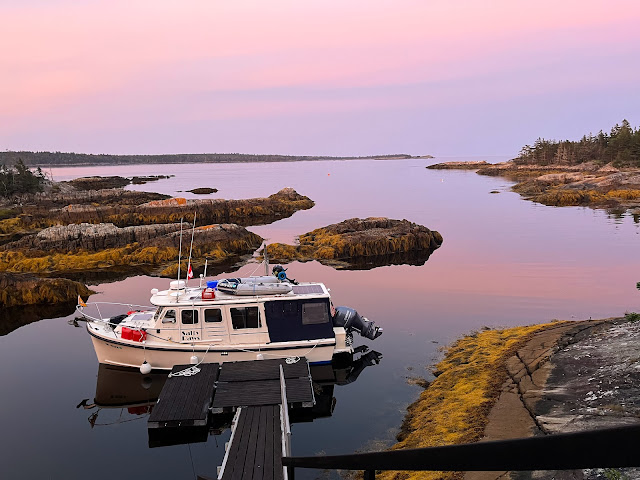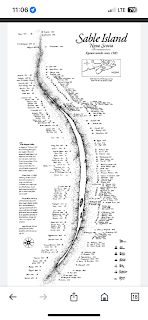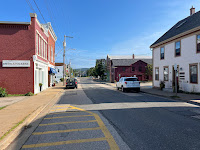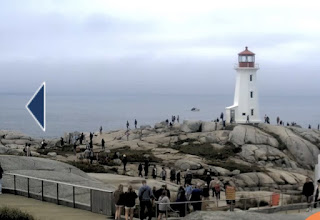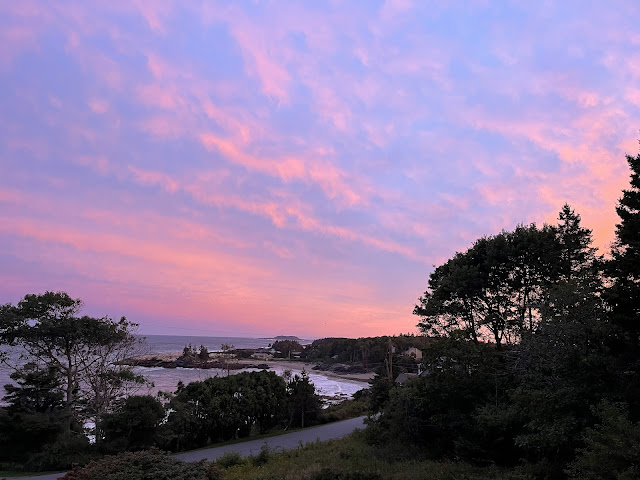 |
| Molly took this picture looking toward our cottage the night before Lee, now a tropical storm, arrived. |
 |
| Ground Zero in early November 2001. |
Dick and I awoke in Annapolis Royal, Nova Scotia, on Monday, September 11th. We talked about that day in 2001, and I reflected on our family visit to New York City less than two months after the tragic event. Caroline and I visited Ground Zero, one of the most emotional visits of my life. Signs of patriotism were everywhere, and the flowers and messages left for loved ones were heart wrenching.
We then turned our attention to the updated weather forecast for Hurricane Lee. It looked like Maine or Nova Scotia might well get a direct hit, and I knew that Molly was anxious for my return. The decision was made to head the 250 miles home and forego our plans to see the reversing falls in St. John, New Brunswick, to visit Campobello and to gunkhole back down the Maine coast. “Come Home” was now our mantra, just like the Newfoundland license plate pictured below.
 |
| The Bay of Fundy. |
The fog was thick, the winds nonexistent and the Bay of Fundy like glass. We wanted to conserve fuel as we weren’t sure where our next fuel stop would be. Salty Paws cruised along at 9 mph, and for 10 hours we saw no land. We did see one huge tanker, several guillemots, gulls, gannets and seaweed. We also had a brief encounter with one small bird that came close to flying right into our cabin. Dick enjoyed seeing me frantically flapping my arms to keep the bird out. Our visitor rested on our foredeck for a few seconds before flying off. I have never had an avian hitch-hiker, but Dick has encountered them many times while sailing.
As we approached US waters, I used the US Customs app to apply for re-entry to our country. About 10 minutes after hitting the send button, I received the message “Unfortunately, your application has not been approved and you may not enter the U.S. at this time. You may contact the nearest Port of Entry for information or clarification.” Yikes!
After an Internet search I was finally able to get a phone number and contacted the Lubec Customs office. I learned that our boat had probably still been in Canadian waters and that led to the rejection. After re-applying, we were soon contacted by a Customs official. We video-conferenced so he could see our faces and get a tour of the boat. He was satisfied and welcomed us back to the U.S.
Dusk was now approaching, and with our radar and GPS we found the entrance to Cutler Harbor. We eased Salty Paws into the inner harbor and passed a lobster boat with four people sorting the day’s catch. They were happy to direct us to an open mooring for the night.
Dick sleeps in the cabin while I sleep in lower v-berth so he hears and sees a lot more than I do. From 3:30 am on his slumber was interrupted by departing lobster boats while I continued my beauty rest until almost 5:30 am. I decided that the least I can do is make a nice breakfast of two hole-in-the-walls each (eggs fried in a hole in a piece of bread).
 |
| The yellow dots are lobster boats. |
We determined that we have enough gas to go the 65 miles to Northeast Harbor on Mt. Desert Island where we can refuel and possibly make Port Clyde for the night. Again, it was foggy, but our radar easily showed the location of the working lobster boats. We follow the course plotted to Mt. Desert, while dodging lobster boats along the way. At one time the fog temporarily lifted, and we counted 10 lobster boats within two miles of Salty Paws.

After almost 10 hours of travel, Salty Paws pulled into Robinhood with 2,800 miles behind her. Soon Molly and Tory were on the dock, and Tory gave me the most excited welcome home I have ever had including peeing all over the dock.
Addendum #1
 Salty Paws was pulled out of the water two days before Lee, and Molly an I were able to get the house ready for the blow. Lee arrived on Saturday, September 16th, now as a tropical storm. We experienced high surf and northwest wind gusts approaching 60 mph, but had no damage or flooding. The power did go out, but our generator, relocated from the boat, keep our lights on and refrigerator cold. All is good.
Salty Paws was pulled out of the water two days before Lee, and Molly an I were able to get the house ready for the blow. Lee arrived on Saturday, September 16th, now as a tropical storm. We experienced high surf and northwest wind gusts approaching 60 mph, but had no damage or flooding. The power did go out, but our generator, relocated from the boat, keep our lights on and refrigerator cold. All is good.
Addendum #2
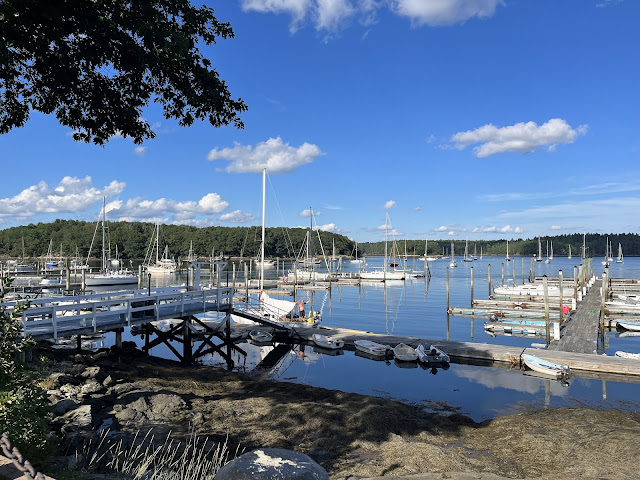 |
| This is Robinhood, our home marina, two days before Lee arrived. The marina instituted hurricane procedures which meant that all boats either had to be hauled out or put on moorings. |
 |
| Lee arrived with 10-15 foot surf from the southeast, but the northwest winds kept the waves from washing over all the rocks into our yard. |
 |
| The surf pounded the other side of our cove, but we were spared most of the force. |









